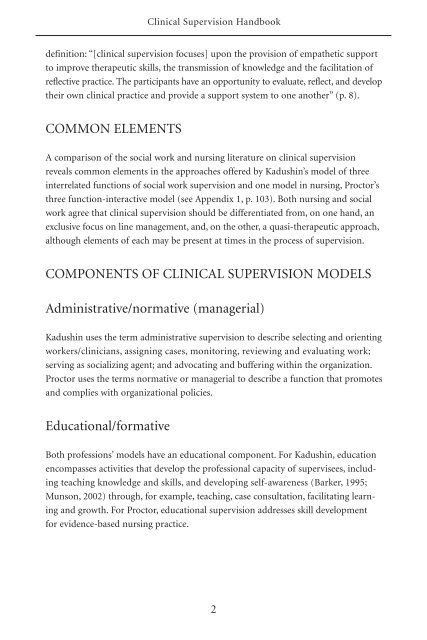Clinical Supervision Handbook - CAMH Knowledge Exchange ..
You also want an ePaper? Increase the reach of your titles
YUMPU automatically turns print PDFs into web optimized ePapers that Google loves.
<strong>Clinical</strong> <strong>Supervision</strong> <strong>Handbook</strong><br />
definition: “[clinical supervision focuses] upon the provision of empathetic support<br />
to improve therapeutic skills, the transmission of knowledge and the facilitation of<br />
reflective practice. The participants have an opportunity to evaluate, reflect, and develop<br />
their own clinical practice and provide a support system to one another” (p. 8).<br />
COMMON ELEMENTS<br />
A comparison of the social work and nursing literature on clinical supervision<br />
reveals common elements in the approaches offered by Kadushin’s model of three<br />
interrelated functions of social work supervision and one model in nursing, Proctor’s<br />
three function-interactive model (see Appendix 1, p. 103). Both nursing and social<br />
work agree that clinical supervision should be differentiated from, on one hand, an<br />
exclusive focus on line management, and, on the other, a quasi-therapeutic approach,<br />
although elements of each may be present at times in the process of supervision.<br />
COMPONENTS OF CLINICAL SUPERVISION MODELS<br />
Administrative/normative (managerial)<br />
Kadushin uses the term administrative supervision to describe selecting and orienting<br />
workers/clinicians, assigning cases, monitoring, reviewing and evaluating work;<br />
serving as socializing agent; and advocating and buffering within the organization.<br />
Proctor uses the terms normative or managerial to describe a function that promotes<br />
and complies with organizational policies.<br />
Educational/formative<br />
Both professions’ models have an educational component. For Kadushin, education<br />
encompasses activities that develop the professional capacity of supervisees, including<br />
teaching knowledge and skills, and developing self-awareness (Barker, 1995;<br />
Munson, 2002) through, for example, teaching, case consultation, facilitating learning<br />
and growth. For Proctor, educational supervision addresses skill development<br />
for evidence-based nursing practice.<br />
2


